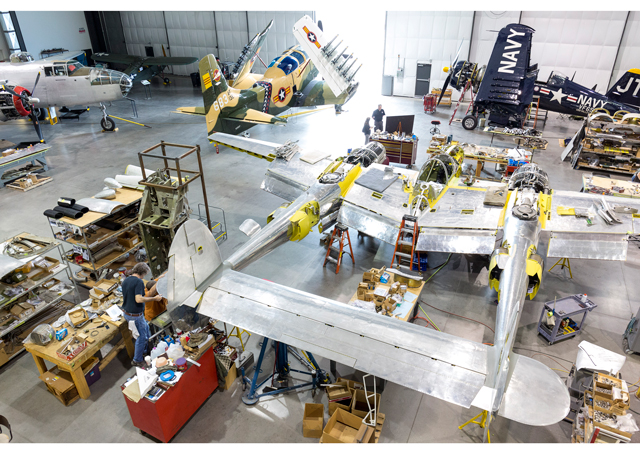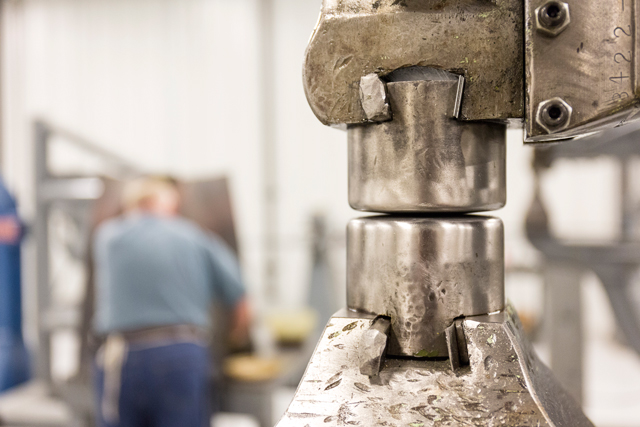
The twin-tailed Lockheed P-38 Lightning flew more than 130,000 missions during World War II, shot down more Japanese aircraft than any other fighter, and earned the nickname “fork-tailed devil” from its impact on enemy forces. The sleek, fast fighter boasts a distinctive design—but a crumpled section of a P-38 at WestPac Restorations in Colorado Springs in June was barely recognizable as an airplane.
“Most people would see that and say, ‘Take anything you can get,’” said WestPac President Bill Klaers, pointing to the mangled metal. At WestPac, however, it’s the start of a project.
The restoration facility takes the flying machines of World War II down to the spars and rebuilds them, using as many original parts as possible and manufacturing the rest at its full-service metal forming shop and maintenance facility. Across the shop, a P-38 nearing completion stood in sharp contrast to the crumpled metal: New hydraulics, cables, and tubing; straightened metal of what could be saved from the original; and meticulous reconstruction work gave it the appearance of a new airplane.
Dubbed the White 33 project for the numbers on its tail, this aircraft with combat history was recovered on an island in the Pacific. “This is a pretty iconic airplane, so this goes back to exacting standards,” said Klaers, who is also president and CEO of the neighboring National Museum of World War II Aviation and co-chairman of its board of directors.
“Exacting standards” is an apt description for any of the warbirds taking shape on the hangar floor. Some customers want to fly their World-War-II-era warbirds for another 60 years, Klaers said. His company tries to use as many of the original parts as it can; workers take the aircraft apart, straighten everything they can, and build the rest from scratch.
The capacity to build parts for these historic aircraft from scratch enables WestPac to restore a wide variety of World-War-II-era aircraft in exacting detail—the metal forming shop alone is almost capable of scratch-building a P-51 Mustang, Klaers said. But even the variations from a J to an L model of the P-38 preclude any sort of assembly-line-style efficiencies.
More than 10,000 P-38s, comprising 18 distinct models, were manufactured during World War II, according to Lockheed. Every model was a different variant, so one can’t use the same dyes in the metal forming shop, Klaers said.
“If you line them all up, they all look the same,” he said. “They’re not. … You’re really having to build each and every variant from scratch.”
Next door, the National Museum of World War II Aviation houses several of WestPac’s former projects, immaculate machines that bring World War II to life for tour groups and students. Museum leaders don’t view the exhibits as static artifacts; the facility is set up to bring history to life. Klaers said that when he needs to perform an engine test or maintenance on one, he’ll wait for a tour or class to come through so that visitors can see the airplane in action. Docent-led tours and interactive programs for school groups allow the museum to provide an interactive, educational experience for all who come.
“We don’t want it to become another wax museum,” Klaers said.
The museum tells the story of World War II aviation, from developments on the home front to the years in theater. Through the school programs, students learn principles of science, technology, engineering, and math in the context of an important time in the nation’s history. A volunteer program provides an avenue for young people to take classes in sheet metal, propellers, or other maintenance topics.
The museum’s 44,000-square-foot facility opened in 2012 as what Klaers calls a “pitch room” for a future iteration, a larger structure featuring a B-25 Mitchell bomber suspended from the atrium ceiling and more space for educational programs—and more space for WestPac’s meticulous restorations.
“It’s all about education and letting people see something like this,” Klaers said.
The National Museum of World War II Aviation will offer a reduced admission rate of $5 Sept. 26 during the AOPA Colorado Springs Fly-In. See the website for details. A shuttle is available from the fly-in.
Join AOPA in Colorado Springs
AOPA comes to Colorado Springs for an AOPA Fly-In Sept. 26. RSVP online to reserve your meal ticket and let the association know you’re coming. This AOPA Fly-In has been made possible by a generous grant from the AOPA Foundation. Visit foundation.aopa.org for more details.


